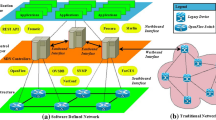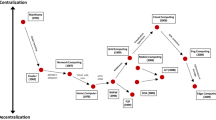Abstract
An operator net is a graph consisting of nodes and directed arcs. While operator nets are syntactically similar to dataflow nets, they completely separate the operational semantics from the mathematical semantics. In this paper we define an operational semantics for operator nets that intuitively corresponds to communication in a distributed system. The operational semantics of operator ator nets provide a formal model for a distributed system that is an intermediate point between the actual system and a mathematical model. Abstract properties are expressed using relations on events and messages of an operator net. Corresponding operational specifications can be written using Lucid equations that define a node as a mathematical function on infinite history sequences. The operational specifications are executable and can be easily transformed into a practical implementation of the system. Examples of such specifications are included in the paper.
Similar content being viewed by others
References
Arvind (1977) Some relationships between asynchronous interpreters of dataflow. Formal Description of Programming Language IFIP Working Group 2.2
Ashcroft EA, Wadge WW (1976) Lucid: a formal theory for writing and proving programs. SLAM J Comput 5:336–354
Ashcroft EA, Jagannathan R (1985) Operator nets. Proceedings of IFIP TC-10 Working Conference on Fifth-Generation Computer Architectures. North Holland
Brock JD, Ackerman WB (1981) Scenarios: a model of nondeterminate computation. International Colloquium on Formalization of Programming Concepts
Broy M (1988) Nondeterministic data flow programs: how to avoid the Merge anomaly. Trans Comput Syst 10:65–85
Chandy KM, Lamport L (1985) Distributed snapshots: determining global states of distributed systems. ACM Trans Comput Syst 3:63–75
Chen B, Yeh RT (1983) Formal specification and verification of distributed systems. IEEE Trans Sofware Eng SE 9:710–721
Conway ME (1963) Design of a separable transition-diagram compiler. Commun ACM 6:396–408
Dijkstra EW (1976) A discipline of programming, Pretice-Hall, Englewood Cliffs, New Jersey
Faustini AA, Lewis EB (1986) Toward a real-time dataflow language. IEEE Trans Software Eng 3:29–35
Faustini AA, Mathews SG, Yaghi AA (1983) The pLucid programming manual. Department of Computer Science, University of Arizona, Tempe, Arizona
Glasgow JI, Quabdesselam F, MacEwen GH, Mercouris T (1984) Specifying multi-level security in a distributed system. NBS/DOD Computer Security Conference, Gaithersburg, MD, (September 1984)
Glasgow JI, MacEwen GH (1985) Lucid: a specification language for distributed system. Verification Workshop III, Watsonville, California, February 1985. ACM Software Eng Notes (August 1985)
Glasgow JI, MacEwen GH (1985) A two-level security model for a secure network. Proceedings of the Eighth National Computer Security Conference, Gaithersburg, MD (September 1985)
Glasgow JI, MacEwen GH (1987) A computational model for distributed computing using operator nets. Proceedings of Parallel Architectures and Languages Europe (PARLE). (Lect Notes Compnt Sci 259, pp 243–260) Springer, Berlin Heidelberg New York Tokyo
Glasgow JI, MacEwen GH (1987) The development and proof of a formal specification for a multi-level secure system. ACM Trans Compu Syst 5:151–184
Glasgow JI, Panangaden P (1988) A semantics for nondeterministic operator nets. Proceedings of International Symposium on Lucid and Intensional Programming, Victoria, Canada
Kahn G (1974) The semantics of a simple languae for parallel processing. Proceedings of IFIP Congress 74, pp 472–475
Kahn G, McQueen D (1977) Coroutines and networks of parallel processes. Proceedings of IFIP Congrees 77, pp 993–998
Karp RM, Miller RE (1969) Parallel program schemata. J Comput Syst Sci 3:147–195
Keller RM, Panagaden P (1986) Semantics of networks containing indeterminate operators. Distrib Comput 1:235–245
Knuth DE (1981) Seminumerical algorithms. The Art of computer Programming, vol 2, 2nd edn. Addison Wesley
Kok JN (1987) A Fully abstract semantics for dataflow nets. Proceedings of Parallel Architectures and Languages Europe (PARLE) (Lect Notes Comput Sci 259, pp 351–368) Springer, Berlin Heidelberg New York Tokyo
MacEwen GH, Lu Z, Burwell B (1984) Multi-level security basd on physical distribution. Proceedings of IEEE Symposium on Security and Privacy, Oakland, pp 167–177 (April 1984) Also presented at NBS/DOD Computer Security Conference, Gaithersburg, MD, (September 1984)
MacQueen DB (1979) Models for distributed computing. INRIA Rep 351 (April 1979)
Manna Z (1974) Mathematical theory of computation. McGraw Hill
Manna Z, Pnueli A (1984) Adequate proof principles for invariance and liveness properties of concurrent programs. Sci Comput Program 4:257–289
Misra J, Chandy KM (1981) Proofs of networks of processes. IEEE Trans Software Eng SE-7:417–526
Nguyen V, Gries D, Owicki S (1984) A model and temporal proof system for networks of processes. 11th Annu Princ Program Lang, pp 121–131
Nguyen V, Demers A, Gries D, Owicki S (1986) A model and temporal proof system for networks of processes. Distrib Comput 1:7–25
Panangaden P (1984) Abstract interpretation and indeterminacy. Proceedings of the 1984 CMU Seminar on Concurrency, (Lect-Notes Comput Sci 197, pp 497–511) Springer, Berlin Heidelberg New York Tokyo
Panangaden P, Stark EW (1988) Computations, residuals, and the power of indeterminacy. Proceedings of the 1988 ICALP
Park D (1982) The fairness problem and nondeterministic computing networks. Proceedings of the 4th Advanced Course on Theoretical Computer Science
Peterson JL (1981) Petri net theory and the modeling of systems. Prentice-Hall, Englewood cliffs, New Jersey
Pratt V (1982) On the composition of processes. 9th Annu ACM Symp Princ Program Lang, pp 213–223
Skillicorn D, Glasgow JI (1989) Real-time specification using lucid. IEEE Trans Software Eng 15:221–229
Stoy JE (1977) Denotational semantics: the Scott-Strachey approach to programming language theory. MIT Press, Cambridge, Massachusetts
Wadge WW, Ashcroft EA (1985) Lucid, the dataflow programming language. Academic Press
Zave P (1983) Operational specification language. ACM Annu Conf (October 1983), pp 214–222
Zave P (1982) An operational approach to requirements specification for embedded systems. IEEE Trans Software Eng SE-8:250–269
Author information
Authors and Affiliations
Additional information
Janice Glasgow is an associate professor in the Department of Computing and Information Science at Queen's University. She received her M. Math and Ph.D. degrees from the University of Waterloo. Dr. Glasgow's current research interests include programming language semantics and logics for reasoning about programming.
Glenn H. MacEwen r received the B.Eng. degree in electrical engineering from McGill University, Montreal, P.Q., Canada, in 1962 and the M.Sc. and Ph.D. degrees in computer science from the University of Toronto, Toronto, Ont., Canada in 1967 and 1971, respectively. Since 1970 he has been with the Department of Computing and Information Science at Queen's University, Kingston, Ontario. He served as Head from 1982 to 1987 and is currently a Professor in the department. He is also a director and consultant to Andyne Computing Limited. His research interests include software engineering, computer security, and real-time systems. Dr. MacEwen is a senior member of the Institute of Electrical and Electronics Engineers, and a member of the Association for Computing Machinery and the Association of Professional Engineers of Ontario.
Rights and permissions
About this article
Cite this article
Glasgow, J.I., MacEwen, G.H. An operator net model for distributed systems. Distrib Comput 3, 196–209 (1989). https://doi.org/10.1007/BF01784888
Issue Date:
DOI: https://doi.org/10.1007/BF01784888




